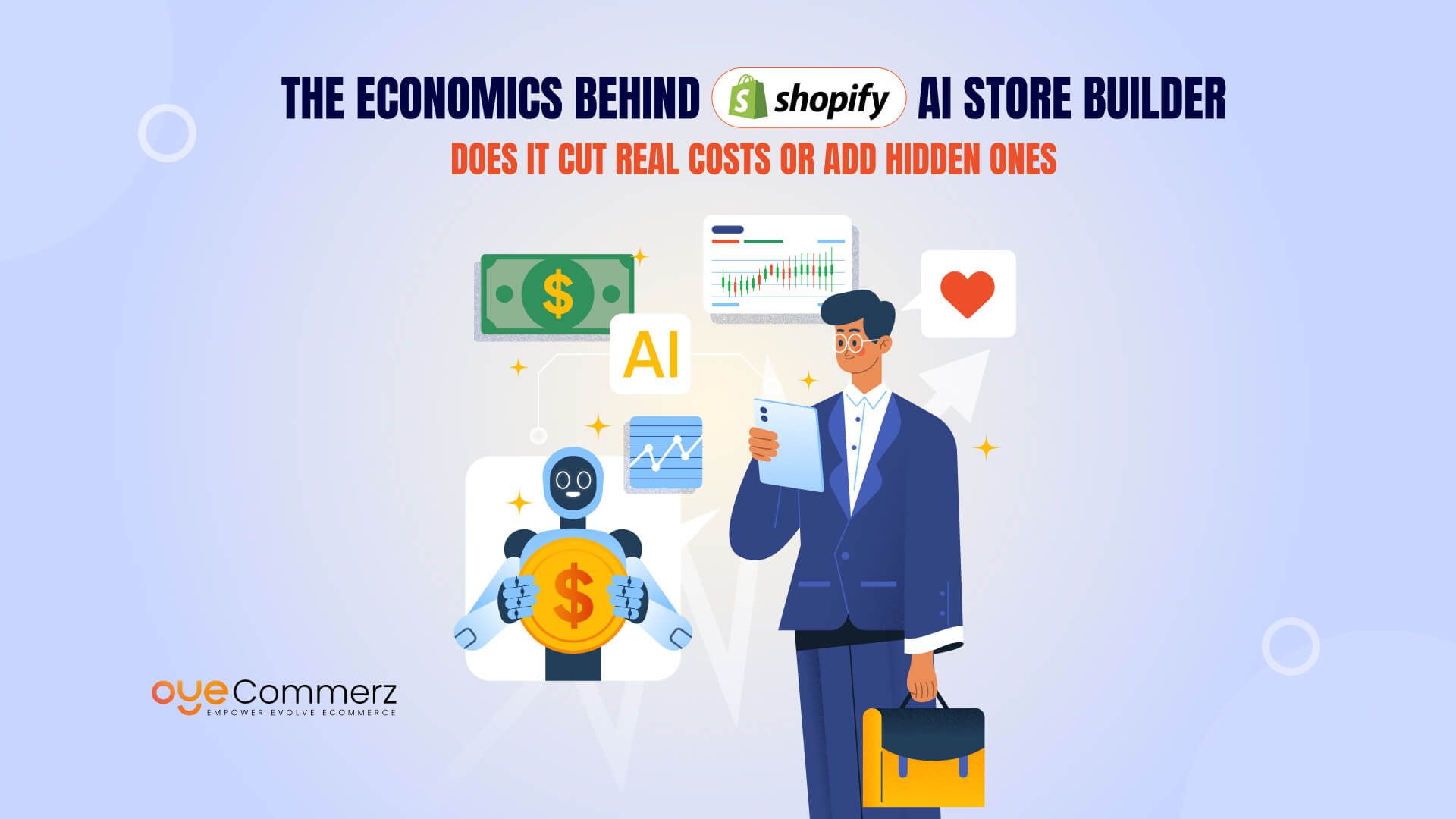Do you know? Shopify powers over 4.8 million websites worldwide, according to Statista, solidifying its dominance in the eCommerce space. Now, with its new AI Store Builder, Shopify is reshaping how online stores are launched, faster, smarter, and more automated. As AI adoption in digital commerce surges, small businesses and entrepreneurs face a crucial question: does this innovation truly reduce costs, or are hidden expenses lurking beneath the surface?
Building an online store traditionally demands time, money, and technical skills. Many SMBs struggle with design complexities, high development fees, and inconsistent content. Shopify’s AI-powered eCommerce tools promise a game-changing alternative: automated design, content creation, and setup, all in minutes.
This blog takes a closer look at the economics of Shopify’s AI Store Builder, helping U.S.-based business owners evaluate its cost-saving potential and long-term value across key Shopify services.
Table of Contents
ToggleShopify’s AI Store Builder- A Game-Changer for Online Store Automation?
Shopify’s AI Store Builder is designed to eliminate traditional eCommerce setup hurdles. This innovative tool transforms the way online stores are built, just by inputting a few keywords, the AI configures a full store in minutes. It selects themes, creates content, and auto-generates product descriptions, all without manual coding or design.
Key Features at a Glance:
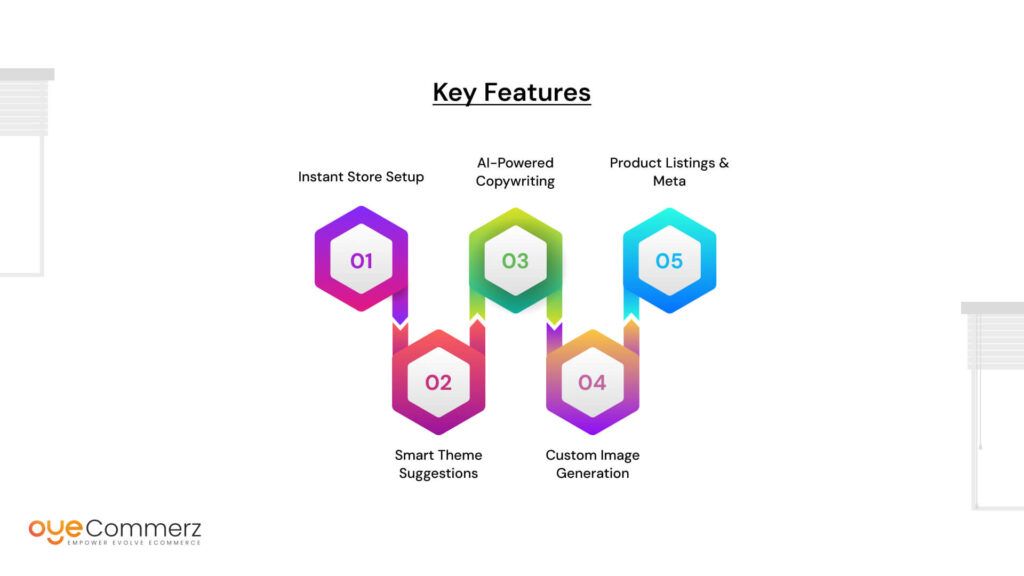
- Instant Store Setup: Input a product idea or brand keyword; AI takes care of layout, content, and visuals.
- Smart Theme Suggestions: Based on store type and industry, it picks optimized themes tailored for performance.
- AI-Powered Copywriting: Automatically writes compelling headlines, product descriptions, and calls to action.
- Custom Image Generation: Generates product visuals and branded graphics through integrated AI tools.
- Product Listings & Meta: Suggests tags, SEO metadata, and inventory details.
This tool leverages Shopify Magic, the platform’s core generative AI engine, and Sidekick, an AI assistant that answers queries and offers guided setup support in real-time. Together, they offer a seamless, conversational experience for first-time store owners and seasoned entrepreneurs alike.
What makes this unique is how it aligns with the AI-in-eCommerce wave, a trend rapidly transforming retail. From Amazon to WooCommerce, automation is rising, but Shopify’s native AI tools are purpose-built for small to midsize businesses, simplifying both front-end creativity and backend efficiency.
For SMBs navigating time, cost, and skill constraints, the Shopify AI Store Builder isn’t just another tool, it’s a full-suite launchpad. It offers speed, accuracy, and customization in a fraction of the time traditional development demands.
As U.S. merchants embrace automation, Shopify’s approach uniquely blends AI innovation with intuitive eCommerce setup, reducing friction and unlocking scalability like never before.
The Traditional Cost of Building a Shopify Store
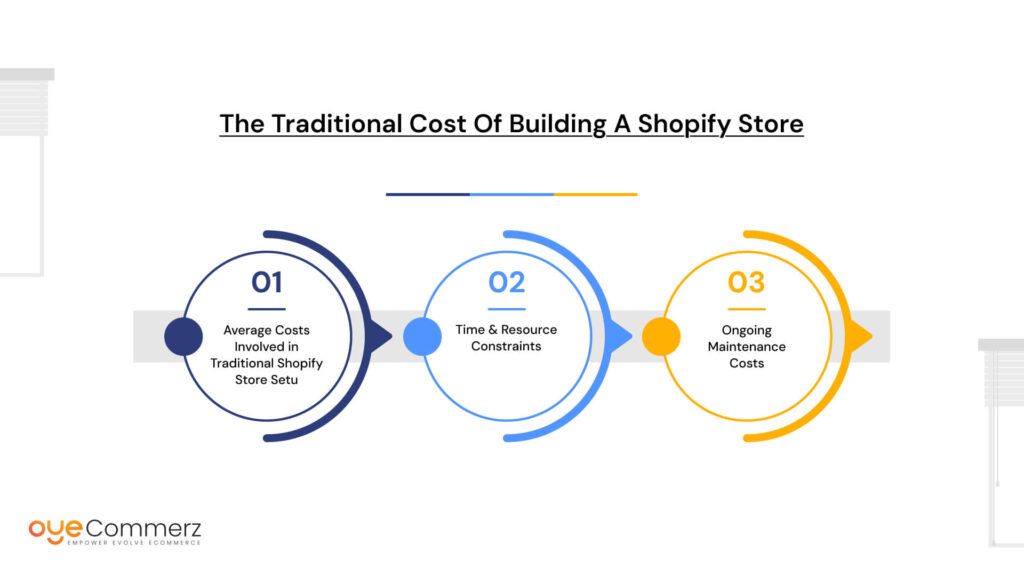
For U.S.-based entrepreneurs and SMBs, creating a Shopify store the traditional way often feels like climbing a steep learning curve, with each step costing time and money. While Shopify’s platform itself is user-friendly, building a fully customized store typically requires hiring professionals, purchasing tools, and investing serious hours, especially if you’re not tech-savvy.
Let’s break down the real expenses:
Average Costs Involved in Traditional Shopify Store Setup:
- Custom Theme Design: $500 to $5,000 depending on complexity and designer experience.
- Development & Coding Support: Starts at $1,000+ for professional developers; hourly rates average $50.
- Copywriting & Content Creation: Up to $300–$700 for quality product descriptions and page content.
- Plugins & App Integrations: $20–$200/month depending on features (email marketing, live chat, upsells).
- Revisions & Edits: Ongoing fees for tweaking design, layout, or SEO content.
Comparative Cost Table
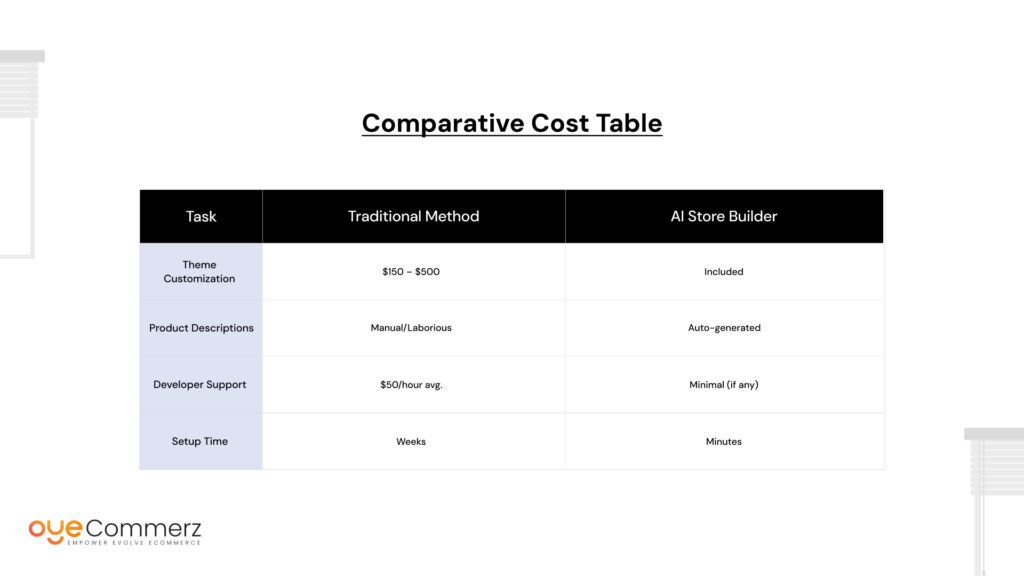
Time & Resource Constraints
For business owners lacking technical expertise, the traditional route is not just costly, it’s overwhelming.
- You juggle multiple freelancers for design, writing, and development.
- You wait days (or weeks) for revisions.
- Even adding a product becomes a multi-step task.
Each minor tweak may require another contract, increasing the long-term cost of ownership. Plus, there’s the hidden time cost: research, communication delays, and app setup.
Ongoing Maintenance Costs
Beyond the launch, small stores need to budget for:
- Regular content updates
- SEO optimization
- App/plugin maintenance
- Mobile responsiveness tuning
These hidden and recurring expenses make traditional Shopify development resource-intensive. In contrast, Shopify’s AI Store Builder aims to eliminate these bottlenecks, offering a streamlined and cost-effective alternative.
Are There Hidden Costs in Shopify’s AI Store Builder?
While Shopify’s AI Store Builder simplifies store creation, it’s essential to look beyond the surface. Automation doesn’t always mean total savings, and in many cases, AI introduces its own set of limitations that could cost merchants in time, branding, or growth potential.
Key Concerns:

Generic AI-Generated Content
The AI may produce functional copy, but it often lacks personality or alignment with your brand voice. Businesses may still need to manually rewrite product descriptions, headlines, or about pages, adding time or freelance costs back into the equation.
Template Fatigue and Uniformity
Since many stores use the same AI-generated layouts, design uniformity can reduce uniqueness, making it harder to stand out. Consumers may recognize the “AI look,” which impacts perceived value or trust in your brand.
No Plugin-Free Growth
AI can help you launch, but premium plugins remain essential for advanced functions, email automation, loyalty programs, or upselling tools still cost extra. These are not absorbed into the AI suite and remain out-of-pocket expenses.
Potential Upsells via Plan Upgrades
While the AI builder is accessible, many advanced features or deeper customizations may require upgrading to higher Shopify plans, especially for scaling stores needing analytics, staff accounts, or shipping discounts.
Shopify Pricing Structure Breakdown
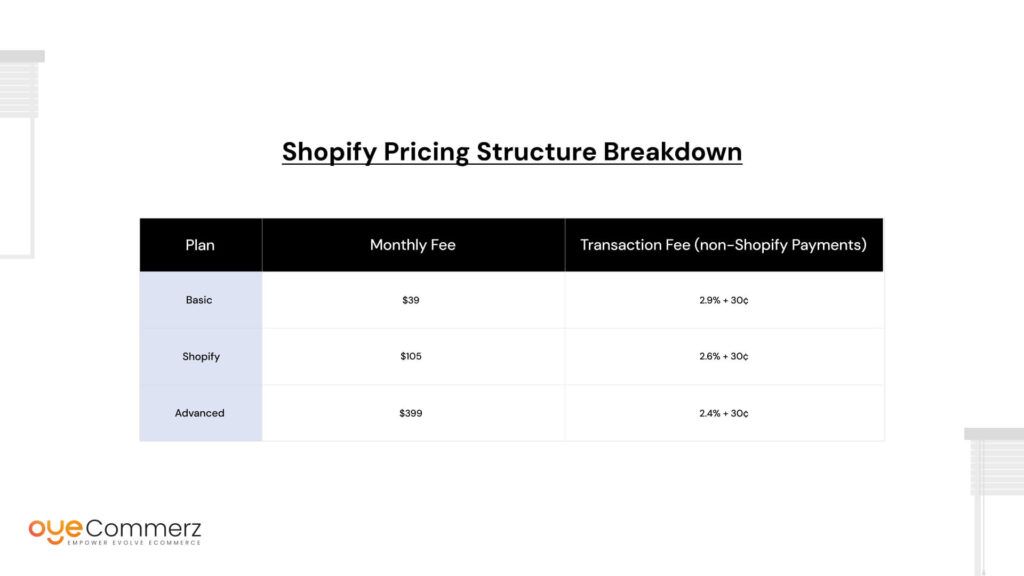
Higher tiers offer more capabilities and reduced fees, but for SMBs, this can escalate operating costs, especially when combining with additional plugin subscriptions.
In short, while Shopify’s AI Store Builder cuts setup time, hidden costs in branding, flexibility, and scaling remain. Businesses must weigh convenience against the potential need for human intervention, plugins, and plan upgrades.
How Shopify’s AI Store Builder Cuts Real Costs
For entrepreneurs and small businesses trying to launch fast and lean, Shopify’s AI Store Builder offers a real economic advantage. This tool significantly reduces time, cost, and dependency on technical resources, making eCommerce more accessible and affordable.
Key Cost-Cutting Benefits:

70% Faster Time-to-Launch
Traditional store setups can take weeks. With Shopify’s AI Store Builder, users can generate a fully functional store in minutes, cutting time-to-market by over 70%.
No Need for Costly Contractors
Expensive designers, developers, and copywriters are typically essential in building a professional Shopify store. The AI eliminates this need by auto-generating store themes, product descriptions, and even visual content, significantly lowering startup costs.
Ideal for MVP Testing and Startups
For businesses exploring product-market fit or launching a minimum viable product (MVP), Shopify’s AI tool is perfect. It allows for low-investment, high-speed store creation to validate business ideas before committing to larger spends.
Unified Workflow via Shopify Magic & Sidekick
The builder integrates seamlessly with Shopify Magic (generative AI for content and imagery) and Sidekick (AI assistant for business operations), allowing store owners to manage everything from one ecosystem without juggling multiple tools.
Catalog to Copy in One Flow
Generative AI handles product categorization, descriptions, banner texts, and even marketing copy. For busy entrepreneurs, this saves countless hours of manual input and ensures consistency across the store.
In essence, Shopify’s AI Store Builder offers a clear pathway to cost efficiency for those prioritizing speed, automation, and scalability, especially in the early stages of their eCommerce journey. It delivers real savings in setup time, creative resources, and initial development, without sacrificing essential functionality.
What the AI Store Builder Can’t (Yet) Solve
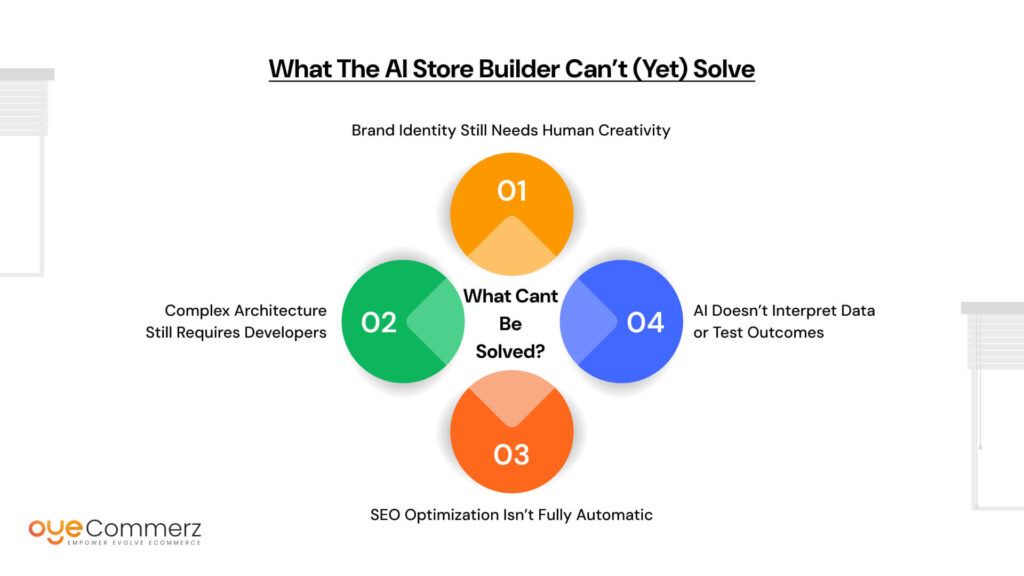
While Shopify’s AI Store Builder offers significant automation and affordability, it isn’t a magic bullet. Entrepreneurs looking to build standout eCommerce brands must understand the tool’s current limitations. It accelerates the foundation, but fine-tuning still needs a human touch.
Brand Identity Still Needs Human Creativity
AI can generate product descriptions, homepage text, and even headlines, but it doesn’t feel your brand. Authentic storytelling, emotional tone, and cultural context are areas where human input is irreplaceable. Strong brands thrive on distinct messaging and voice, which AI often dilutes into generalized or repetitive content.
If your brand identity hinges on narrative, humor, social values, or highly targeted demographics, relying solely on AI copy may create a forgettable experience. The builder lacks the nuance to align design and language with your unique selling proposition (USP).
Complex Architecture Still Requires Developers
The AI Store Builder handles simple store layouts efficiently, but stores needing custom workflows, dynamic product bundling, subscription models, or advanced filtering systems require development expertise. Shopify’s liquid coding flexibility is still best utilized by a professional when deeper customization is needed.
Features like conditional logic in checkout flows, app integrations with CRM platforms, or real-time inventory updates across marketplaces still lie outside AI’s automated capabilities.
SEO Optimization Isn’t Fully Automatic
While AI generates content quickly, SEO involves far more than word count or keyword presence. Effective SEO requires:
- Intent-based keyword targeting
- Internal linking structure
- Schema markup integration
- Meta tags optimization
- Local SEO strategy (if applicable)
AI-generated text may rank for basic keywords but often lacks the strategic depth needed to compete in saturated niches. Shopify users still need SEO tools, plugins, or specialists to implement long-term organic visibility strategies.
AI Doesn’t Interpret Data or Test Outcomes
Understanding analytics is a critical growth driver. Although Shopify’s backend provides robust performance data, the AI Store Builder doesn’t analyze or act on this information.
- No A/B testing tools: AI won’t compare page variations for performance.
- No dynamic optimization: It won’t suggest improvements based on bounce rate or conversions.
- No market responsiveness: Trends shift, but AI doesn’t adapt copy or UX based on external signals.
These tasks demand human judgment and marketing experience. Store owners must review analytics and adjust strategies accordingly, or hire professionals who can.
Know Its Limits to Use It Wisely
Shopify’s AI Store Builder is an excellent tool for launching fast and affordably. But as your store scales, it must evolve beyond templated automation. Brand-building, performance optimization, and unique shopping experiences still need real-time human insight.
In short, it simplifies launch, not longevity. Use it for speed and scalability, but pair it with strategy, creativity, and analytics expertise for sustainable growth.
Long-Term Economic Impact on Small and Mid-Sized Businesses
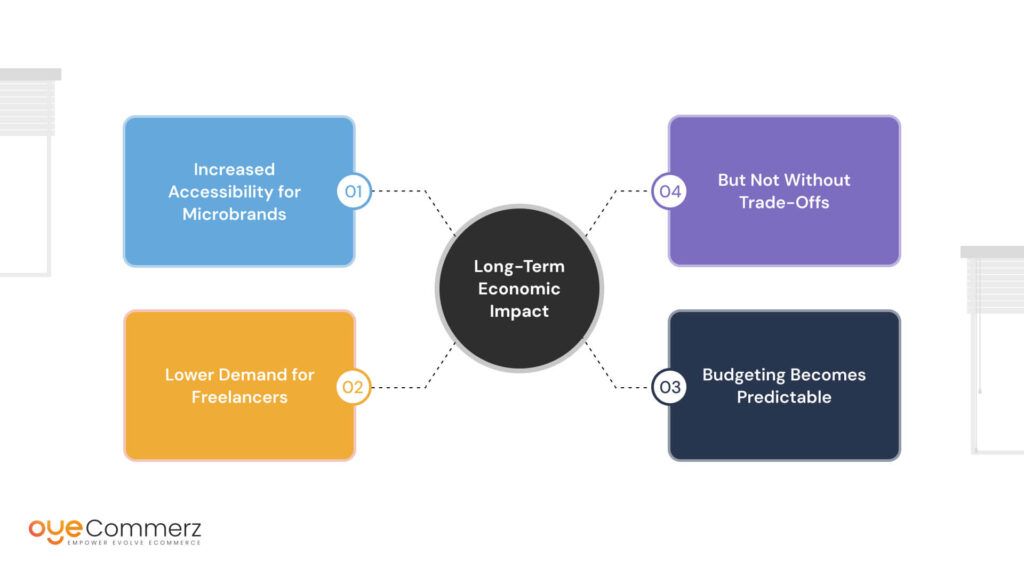
The Shopify AI Store Builder brings transformative potential for small and mid-sized businesses (SMBs), especially microbrands and solo entrepreneurs. As of 2024, Shopify powers over 4.6 million websites globally, and the accessibility of its AI tools marks a significant shift in digital retail economics.
Increased Accessibility for Microbrands
AI integration lowers the technical barrier for first-time entrepreneurs. Anyone with a product idea can now input basic prompts and launch a fully functional store in under an hour, without needing to know code, hire designers, or write sales copy. This democratizes eCommerce and reduces time-to-market drastically.
Lower Demand for Freelancers
Previously, SMBs had to allocate part of their budget to developers and designers. These roles often cost:
- Developers: $50–$150/hour
- Designers: $500–$3,000/project
- Copywriters: $100–$300/page
With the AI Store Builder handling these basic tasks, the need for hiring external help reduces significantly, at least in the initial stages. It empowers business owners to be self-sufficient.
Budgeting Becomes Predictable
Traditional store-building comes with fluctuating costs, scope creep, and unexpected revisions. The AI Store Builder allows for more predictable budgeting:
- Theme suggestions and design-Included
- Copy and images-Auto-generated
- Updates-Seamless through Shopify backend
The result? Flat monthly platform fees, clear deliverables, and fewer billing surprises.
But Not Without Trade-Offs
With more automation comes more uniformity. AI-generated stores often share visual and structural similarities, which can lead to market saturation. Businesses may struggle to differentiate without investing in custom features or branding elements later on.
Additionally, over-reliance on automation can stunt a brand’s growth. When store owners don’t engage in analytics, user feedback, or content strategy, opportunities for innovation are missed.
Scale vs. Customization Trade-Off
While Shopify’s AI Store Builder accelerates setup and lowers initial costs, it offers limited customization. As businesses scale, they often outgrow template-based solutions and must reinvest in more tailored development.
In essence, the tool is perfect for starting lean, but businesses aiming for long-term brand equity must still plan for creative input, SEO optimization, and performance strategy.
Strategic Tips for Cost-Efficient Use of Shopify’s AI Store Builder

To truly harness the power of Shopify’s AI Store Builder without overspending, strategy is key. Below are actionable tips that ensure cost-efficiency while maximizing performance:
1. Use AI for First Drafts, Then Refine for Branding
Let the AI handle the heavy lifting, like product descriptions, landing pages, and emails. However, always review and polish content manually to reflect your unique brand voice. This ensures your messaging stands out and avoids sounding robotic or generic.
2. Combine Free Apps Thoughtfully
Shopify’s App Store includes a mix of free and premium apps. Instead of purchasing multiple tools with overlapping functions, strategically integrate free apps that meet your core needs. For instance, choose one solid free SEO tool and one marketing automation app rather than multiple redundant ones.
3. Leverage Shopify Sidekick for Operations
Sidekick, Shopify’s AI assistant, can answer support questions, track inventory, and suggest improvements. It’s ideal for solo entrepreneurs handling everything themselves. Use it to monitor performance, generate reports, and even draft marketing emails.
4. Scale Gradually Based on Traffic
Start with the Basic plan ($39/month) and evaluate needs only after your store sees consistent traffic. Avoid committing to advanced plans unless you’re reaching traffic thresholds or need advanced analytics, shipping tools, or reports.
5. Use External SEO Tools
While Shopify’s AI can write SEO-friendly content, third-party SEO tools like Ubersuggest or Moz offer deeper keyword insights, backlink monitoring, and rank tracking. They help improve visibility and organic reach over time, areas where AI-generated content might fall short.
By layering automation with thoughtful manual tweaks, you can reduce initial costs while setting your store up for scalable, sustainable success. The key lies in blending AI convenience with human creativity and strategic choices.
Should You Migrate from Traditional Setup to Shopify’s AI Store Builder?
With the launch of Shopify’s AI Store Builder, many online business owners are asking: Is it time to switch? While the platform promises fast setup and lower upfront costs, the decision hinges on your specific needs and stage of business.
For new entrepreneurs, the AI builder is a strong starting point. If you’re operating on a tight budget and need a functioning storefront within hours, not weeks, Shopify’s AI tool can save both time and money. It’s especially useful for testing product ideas or launching MVPs without investing in custom development.
However, established brands may find limitations. If you require complex product categorization, intricate site architecture, or want full-stack control, the AI-generated templates might feel restrictive. Design limitations and generic content could dilute your brand identity if not properly refined.
You should also consider risk factors: over-reliance on AI features can limit your flexibility as your business grows. Additionally, evolving AI tools can change functionality or pricing structures, leading to potential disruptions
Decision-Making Checklist.
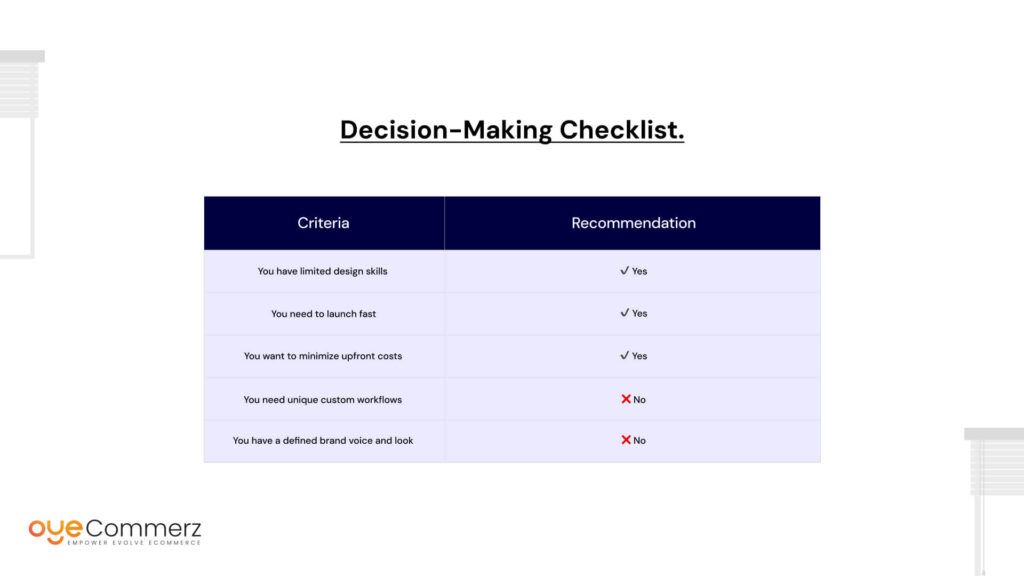
Ultimately, Shopify’s AI Store Builder is ideal for speed, affordability, and simplicity. But it’s not a one-size-fits-all solution. Weigh its automation benefits against your long-term goals and branding needs. Migration makes sense when launching lean, but for full-scale, nuanced eCommerce operations, a traditional or hybrid approach may still reign.
Ready to launch your store smarter, faster, and more affordably?
At OyeCommerz, we specialize in end-to-end Shopify services that align perfectly with the power of Shopify’s AI Store Builder. Whether you’re starting from scratch or scaling efficiently, our experts help you unlock real value, without the hidden costs.
Let’s build your store with intelligence and intent. Partner with us and get the edge in the evolving world of eCommerce.
Contact to Migrate your Site to Shopify Now
Conclusion
Shopify’s AI Store Builder offers a compelling blend of speed and affordability, especially for startups and small businesses eager to enter the eCommerce space. It drastically reduces time-to-market and initial setup costs while simplifying tasks like theme selection, copywriting, and catalog building.
However, this convenience doesn’t come without caveats. Limitations in customizability, branding, and SEO optimization remind us that full reliance on automation isn’t ideal. For businesses aiming for scalability and a distinct identity, a hybrid approach works best.
Ultimately, Shopify’s AI tool democratizes store creation, but it’s not a one-size-fits-all solution. Blend its automation capabilities with your unique human touch for long-term success. If you’re exploring Shopify services, now is the time to assess your goals, test strategically, and build smart.
Frequently Asked Questions
Yes, aside from monthly plans, costs can include transaction fees, paid apps, premium themes, and third-party integrations.
You input basic info like product type or keywords, and Shopify’s AI builds the store, auto-generating content, layout, and design in minutes.
Plans range from $39/month (Basic) to $399/month (Advanced), plus transaction fees and optional paid apps.
Yes, Shopify’s AI Store Builder creates a store using generative AI, integrated with tools like Shopify Magic and Sidekick.
Not directly, but it charges transaction fees unless you use Shopify Payments, ranging from 2.4% to 2.9% + 30¢ per transaction.

